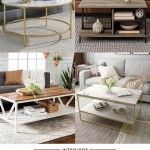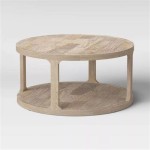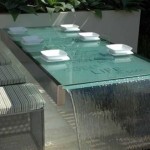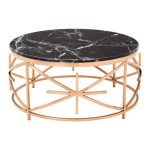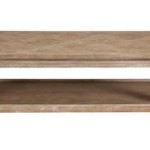Small Coffee Tables and End Tables: A Guide to Choosing the Right Pieces
Small coffee tables and end tables are essential furniture items for any living room or lounge area. They provide functional surfaces for drinks, books, decorative items, and remotes while also contributing to the overall aesthetic of the space. Choosing the right size, style, and material for these pieces is crucial for creating a balanced and comfortable environment.
The terms "small coffee table" and "end table" are often used loosely, but there are some general distinctions. Coffee tables are typically placed in front of a sofa or seating arrangement, providing a central surface for socializing and relaxation. End tables, on the other hand, are positioned beside chairs, sofas, or beds, offering a convenient spot for lamps, reading materials, or personal belongings. The appropriate size and style of each table depend on the specific needs of the room and the existing furniture.
The primary consideration when selecting small coffee tables and end tables is functionality. Before focusing on aesthetics, evaluate the purpose these tables will serve. Will the coffee table primarily hold drinks and snacks during gatherings? Or will it function as a display surface for books and decorative objects? Similarly, consider the purpose of the end tables. Will they need to accommodate a lamp, a charging station, or a stack of reading materials?
Once the functional requirements are identified, the next step is to determine the appropriate size and shape. A coffee table should be approximately two-thirds the length of the sofa and should be positioned about 12 to 18 inches away from the seating. This allows for comfortable legroom while still being within easy reach. The height of the coffee table should be similar to the height of the sofa cushions, typically between 16 and 20 inches. End tables should be roughly the same height as the arm of the adjacent chair or sofa. This ensures that items placed on the table are easily accessible. The shape of the table should complement the shape of the surrounding furniture. A rectangular coffee table might be suitable for a long sofa, while a round or oval coffee table could soften the lines of a more angular room.
Material and style are also important factors to consider. Coffee tables and end tables are available in a wide range of materials, including wood, metal, glass, and stone. The choice of material will influence the overall look and feel of the room. Wood tables provide a warm and inviting atmosphere, while metal tables offer a more modern and industrial aesthetic. Glass tables can create a sense of openness and transparency, while stone tables add a touch of elegance and sophistication.
The style of the table should also complement the existing décor. A traditional living room might benefit from a coffee table with ornate carvings and a rich wood finish. A contemporary living room might be better suited to a sleek and minimalist table made of metal and glass. Consider the color palette of the room when selecting the finish of the table. A dark wood finish can add depth and richness, while a light finish can create a sense of brightness and airiness.
Key Point 1: Optimizing Space with Multifunctional Tables
In smaller living spaces, maximizing functionality is key. Consider opting for small coffee tables and end tables that offer additional storage options. Coffee tables with built-in drawers, shelves, or lift-top mechanisms can provide valuable storage space for remote controls, magazines, and other living room essentials. End tables with drawers or cabinets can be used to store blankets, pillows, or personal belongings. These multifunctional pieces help to keep the room tidy and organized while also providing a convenient surface for everyday use.
Another space-saving strategy is to choose nesting tables. Nesting tables consist of two or more tables of varying sizes that can be stacked together when not in use. This allows you to easily expand the surface area when needed, such as when entertaining guests, and then tuck the tables away when space is limited. Nesting tables are a versatile and practical solution for small living rooms and apartments.
Convertible coffee tables are another popular option for small spaces. These innovative tables can be transformed from a low coffee table into a higher dining table or desk. This is particularly useful for individuals who live in studio apartments or small homes where space is at a premium. Convertible coffee tables provide a flexible and functional surface that can adapt to different needs.
Beyond storage capabilities, consider tables with built-in charging stations. Modern end tables often incorporate USB ports and power outlets, allowing you to conveniently charge electronic devices without cluttering the room with cords. This is a valuable feature for individuals who rely heavily on their smartphones, tablets, and laptops.
Key Point 2: Material Considerations for Durability and Aesthetics
The choice of material significantly impacts the durability and aesthetic appeal of small coffee tables and end tables. Each material offers unique advantages and disadvantages that should be carefully considered before making a purchase. Wood, for example, is a classic and versatile material that provides warmth and character. Solid wood tables are typically more durable and long-lasting than those constructed from engineered wood, such as particleboard or MDF. However, solid wood tables can also be more expensive and require more maintenance to prevent warping or cracking.
Metal tables offer a sleek and modern aesthetic. They are typically more durable than wood tables and are less susceptible to scratches and dents. Metal tables are also easy to clean and maintain. However, they can sometimes feel cold and impersonal. The finish of the metal can also affect its durability. Powder-coated finishes are more resistant to scratches and corrosion than painted finishes.
Glass tables create a sense of openness and transparency, making them a good choice for small rooms. Glass tables are also easy to clean. However, they can be fragile and prone to scratches and chips. Tempered glass is a stronger and more durable option than regular glass. The type of base used with a glass table also affects its stability and overall aesthetic.
Stone tables, such as marble or granite, add a touch of elegance and sophistication to any room. Stone tables are extremely durable and resistant to heat and scratches. However, they are also very heavy and can be difficult to move. Stone tables also require regular sealing to prevent staining.
The material used for the legs or base of the table is also important. Metal legs provide a strong and stable base, while wooden legs offer a more traditional look. Consider the overall style of the room when selecting the material for the legs or base.
Key Point 3: Coordinating Tables with Existing Decor and Room Layout
Successfully incorporating small coffee tables and end tables into a living space requires careful consideration of the existing décor and room layout. The tables should complement the style of the sofa, chairs, and other furniture items. They should also be appropriately sized for the space and positioned in a way that promotes functionality and flow.
Consider the color palette of the room when selecting the finish of the tables. A coffee table with a contrasting color can add visual interest, while a table with a similar color can create a more cohesive look. The texture of the table should also complement the texture of the surrounding furniture. A coffee table with a smooth surface can be paired with a sofa with a textured fabric, or vice versa.
The shape of the table should also be carefully considered. A rectangular coffee table works well with a long sofa, while a round or oval coffee table can soften the lines of a more angular room. Consider the shape of the room itself when choosing the shape of the table.
The placement of the tables is also crucial. A coffee table should be positioned in front of the sofa, within easy reach of all occupants. End tables should be placed beside chairs or sofas, providing a convenient surface for lamps, drinks, and other items. The distance between the tables and the seating should be comfortable and functional.
Pay attention to the overall balance of the room. Avoid placing too many small pieces of furniture in one area, as this can create a cluttered and unbalanced look. Distribute the furniture evenly throughout the room to create a sense of harmony and flow.
Finally, don't be afraid to experiment with different styles and materials. Mixing and matching different types of tables can add personality and visual interest to the room. However, it is important to maintain a sense of cohesiveness and balance. Choose tables that complement each other in terms of style, color, and texture. With careful planning and attention to detail, you can create a living space that is both functional and aesthetically pleasing.

Byblight Allan 31 5 In Walnut And White Round Wood Coffee Table Small With 2 Tier Storage 4 Legs

Lavish Home 19 75 Inch Nesting Coffee Table Small Round Tables Nest Together Brown Set Of 2

Nesting Coffee Table Set Of 3 Glass Side End Tables Small Square Stainless Steel With Grey Tempered 18 Modern Minimalist For Living Room Golden

Harper Bright Designs Gold Round Nesting Coffee Table Set Of 2 Modern Lift Top With Storage Drawers For Small Spaces Natural Wood

Generic 2 Tier End Table For Living Room With Lower Shelf Rustic Farmhouse Design Sy Wood Construction Honey Brown

Nesnesis Modern Round Lift Top Nesting Wood Coffee Tables With 2 Drawers White Natural

Reeve Coffee Table Modern Furniture West Elm

Wonder Comfort Modern 39 37 In Rust Brown Small Rectangle Wood Lift Top Coffee Table With Storage Shelf And Compartment Tn Ct001 Rb

The 10 Best Small Coffee Tables Of 2025

Dextrus Modern Lift Top Coffee Table With Storage Round Center Tables For Living Room Home Office Brown
